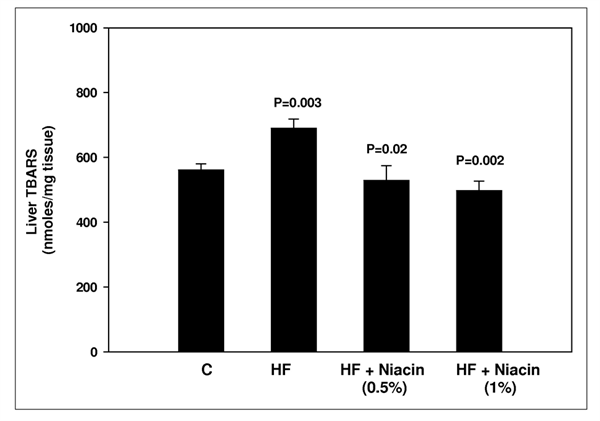New Indication for Use of Niacin (Nicotinic Acid) for Treatment, Prevention and Reversal of Fatty Liver Disease
Brief Description
Non alcoholic fatty liver disease (NAFLD) is a health problem that affects approximately 30% of the population, and the up to 75% of people afflicted with obesity and type 2 diabetes. Currently, no therapeutic agent for the prevention or treatment of fatty liver disease exists.
Researchers at UC Irvine have developed a strategy that suggests treatment for fatty liver disease and/or NAFLD using niacin and/or its metabolites.
Full Description
Non alcoholic fatty liver disease (NAFLD) is characterized by excessive accumulation of triglycerides (fat) in the liver and inflammation, leading to overall liver damage. If left untreated, NAFLD, which affects approximately 30% of the world’s population, leads to liver failure, cirrhosis, and need for liver transplantation. This is often associated with cardiovascular disease, resulting in increased morbidity and mortality.
Currently, no therapeutic agent exists for the prevention or treatment of NAFLD, which encompasses liver damage ranging from the more benign simple fatty liver to non-alcoholic steatohepatitis (NASH), the more progressive form. Studies have shown that insulin sensitizers and antioxidants improve the histological features of NASH, but the lack of large clinical trials have left the value of these drugs to be inconclusive.
Researchers at UC Irvine have developed a treatment for fatty liver disease using niacin and/or its metabolites. A study examining the effects of niacin on rat food intake, body weight, and liver weight was performed. The study involved inducing weight gain in rats using a high fat diet. Inclusion of 0.5% and 1.0% niacin was inserted into the high fat rat diet. Results showed that niacin incorporation into the rat diet reduced liver triglyceride deposition by 60% and also significantly decreased serum triglyceride levels. Additionally, both serum and liver cholesterol levels were decreased in rats that consumed the high fat diet with niacin. Reduced oxidative stress was also demonstrated in rats fed on a high fat diet with added niacin.
It was also shown that niacin significantly inhibited ethanol induced fat accumulation in human hepatocytes.

Overall, the researchers have demonstrated using this in vivo model that niacin is effective in prevention off hepatic steatosis. This suggests that niacin can prevent high-fat-induced NAFLD.
Suggested uses
This strategy can be adapted as niacin formulation or preparation for prevention of hepatic steatosis.
Advantages
Niacin is a well-studied drug, and therefore the side-effects, safe dosage levels, are well known. This technology presents another therapeutic application of niacin.
Patent Status
| Country | Type | Number | Dated | Case |
| United States Of America | Issued Patent | 9,072,732 | 07/07/2015 | 2011-115 |
State Of Development
In vivo Animal studies have been done demonstrating that niacin can prevent development of hepatic steatosis, an early indicator of NAFLD. Further clinical studies need to evaluate the long term effectiveness of niacin to prevent regression of NAFLD and NASH.
Contact
- Alvin Viray
- aviray@uci.edu
- tel: View Phone Number.
